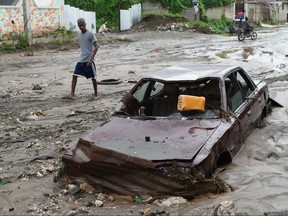
Contents of the article
PORT-AU-PRINCE, Haiti — The Haitian government said Tuesday the death toll from Hurricane Melissa has risen to 43, with 13 more people still missing.
Advertisement 2
Contents of the article
Crews were still trying to contact people in the country's southwestern region, where landslides and floodwaters have destroyed more than 30 communities.
Contents of the article
Contents of the article
At least 25 people were killed in the southwestern coastal town of Petit Goave, one of the worst-hit communities.
The Category 5 storm, one of the strongest Atlantic hurricanes on record, has flooded nearly 12,000 homes and destroyed about 200 more after its outer bands struck Haiti last week. Many roads remain inaccessible.
The government has warned that several communities are facing shortages of drinking water and that it will soon distribute seeds and tools to farmers facing major agricultural losses.
More than 1,700 people remain in shelters.
Meanwhile, in neighboring Jamaica, crews were trying to reach more than two dozen communities that have remained cut off since Melissa made landfall on October 28.
Contents of the article
Advertisement 3
Contents of the article
The storm has killed at least 32 people in Jamaica, and officials warn that number will rise.
Prime Minister Andrew Holness said Tuesday that preliminary, conservative estimates show the storm caused at least $6 billion in damage.
“This is… a major blow to our economy,” he said. “We've never had a disaster of this magnitude.”
The US State Department said Tuesday it has committed $24 million in disaster relief to Caribbean islands hit by Hurricane Melissa. It says that so far $12 million has been allocated for Jamaica, $8.5 million for Haiti, $3 million for Cuba and $500,000 for the Bahamas, and that additional assistance will be announced once estimates are completed.
Mike Bassett, national director of home affairs, humanitarian and emergency affairs at World Vision International, said a potential humanitarian crisis could develop if aid is not delivered quickly.
Advertisement 4
Contents of the article
“I've been doing this for over 10 years and I've never seen anything like this,” Bassett said Tuesday from Jamaica.
He said while visiting storm-damaged communities such as Chester Castle and Cambridge, people were seen bathing in the river and collecting water for drinking due to the lack of electricity and water supply following the storm.
World Vision is among a growing list of international aid agencies and volunteers working independently and with Jamaican officials to distribute aid.
“Aid flights are coming fast and furious, and there is no shortage of supplies,” said Transport and Energy Secretary Daryl Vaz, who co-chairs a special committee created to streamline the government's relief and recovery efforts.
Advertisement 5
Contents of the article
Pearnel Charles Jr., who heads Jamaica's Ministry of Social Welfare, said relief efforts were being ramped up.
“We are coordinating with all available resources,” Charles said, dismissing complaints that not enough was being done to help hurricane survivors quickly enough.
The State Department dispatched disaster response teams and urban search and rescue units from Virginia and California to the affected countries, focusing primarily on Jamaica, where damage from the hurricane appeared to be most severe.
In Jamaica, the department said it responded to about 800 calls for assistance from American citizens living on or traveling to the island, more than half of which came from the Montego Bay resort area. An estimated 11,000 Americans left Jamaica, most of them without assistance from the U.S. government.
The money for Cuba is channeled through the Catholic Church and not through Cuban government agencies, the report said.
—AP Diplomatic Writer Matthew Lee contributed from Washington.
Read more
Contents of the article









